From my travels this past year I would say, Trentino with its sparkling Trentodoc is steadily making progress to internationally showcase its method champenoise wines. Sicily is making progress by leaps and bounds, promoting its wines in some of the world’s most prominent markets and Veneto with its three main appellations of Valpolicella, Soave and Prosecco is one of Italy’s most dynamic regions in terms of production and exports.
Trentino
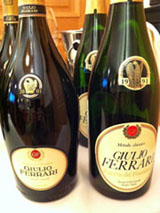 Italy’s northeastern region of Trentino, wedged between Alto Adige and Friuli Venezia Giulia, is currently in the process of reviewing its viticultural sector by implementing a series of new strategies with the aim of creating a clearer ‘branding’. This means a shake-up of the cooperative structure, on which the region was founded. Italy’s northeastern region of Trentino, wedged between Alto Adige and Friuli Venezia Giulia, is currently in the process of reviewing its viticultural sector by implementing a series of new strategies with the aim of creating a clearer ‘branding’. This means a shake-up of the cooperative structure, on which the region was founded.
Cooperative farming in Trentino, as far back as the Hapsburg Empire, has played a fundamental role in all agricultural sectors. Its success stems from the necessity to create an effective economic system for the region’s fragmented farming industry. Over the past 50 years, Trentino’s cooperative ‘cult’ has enabled production to diversify within the sector. It’s the very economic stability provided by the cooperatives that has allowed farmers to break out of the cooperative structure and establish their own wineries – but it’s also these wineries that will play an important role in Trentino’s future.
Trentodoc, formally established as a DOC in 1993, can be traced back historically some 110 years to the production of Giulio Ferrari’s sparkling wine. Trentodoc is by most local authorities considered Trentino’s flagship of quality production, totaling some 8.5m bottles spread over 70 labels and 34 producers.
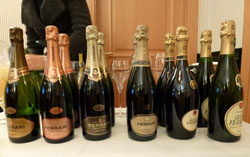 Ferrari, with a turnover of €56.5m is by far the largest and most historic producer of Trentodoc, averaging 4.6m bottles. The main grape varieties in the Trentodoc appellation include Chardonnay, Pinot Noir, Pinot Blanc and Pinot Meunier. At present only 10% is exported. Trentodoc requires a minimum of 15 months ageing; 24 months to be labeled as a vintage; and 36 months to be labeled ‘Riserva’ with the obligation of declaring the vintage. Ferrari, with a turnover of €56.5m is by far the largest and most historic producer of Trentodoc, averaging 4.6m bottles. The main grape varieties in the Trentodoc appellation include Chardonnay, Pinot Noir, Pinot Blanc and Pinot Meunier. At present only 10% is exported. Trentodoc requires a minimum of 15 months ageing; 24 months to be labeled as a vintage; and 36 months to be labeled ‘Riserva’ with the obligation of declaring the vintage.
Out of Italy’s total exports Trentino is not very significant, representing 7.8% in quantity and 8.7% in value. Its main markets over the past five years have been USA 43% and Germany 27%, followed by UK, Austria, Sweden and Canada.
Veneto
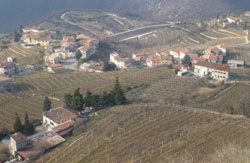 The Veneto region covers some 20 DOC and DOCG appellations and is one of the most important wine-producing regions in Italy, both for quality and quantity. Among its internationally renowned wines are Amarone, Ripasso, Prosecco, Soave and Pinot Grigio. The three most prominent DOCs are Valpolicella, its neighbour Soave, and Prosecco di Conegliano Valdobbiadene, home of Italy’s most famous sparkling wine. The Veneto region covers some 20 DOC and DOCG appellations and is one of the most important wine-producing regions in Italy, both for quality and quantity. Among its internationally renowned wines are Amarone, Ripasso, Prosecco, Soave and Pinot Grigio. The three most prominent DOCs are Valpolicella, its neighbour Soave, and Prosecco di Conegliano Valdobbiadene, home of Italy’s most famous sparkling wine.
The wines of Valpolicella represent some of Italy’s top exports. Sales of Amarone have soared from 5m bottles in 2000 to 12m bottles in 2011, while sales of its ‘younger brother’ Ripasso have almost tripled since 2007, from 7.5m bottles to 20m bottles in 2011. In 2000, the value of wines from the Valpolicella was €160m; today it’s €300m.
Amarone is a big fruity wine with 15- 17% alcohol; if well balanced, however, the alcohol does not dominate. Its colour is intense and bright, the nose has aromas of cherry, redcurrant, chocolate and spice, the palate is rich in extract, full bodied, yet soft, round, balanced and elegant. Its soft tannins and rich fruit allow Amarone to be enjoyed when it is young, although it is also a magnificent age-worthy wine to cellar and appreciate in its maturity.
Soave is Italy’s flagship white wine. Its production zone, east of Verona, is of volcanic origin and is rich in mineral soils. Its hilly areas offer diverse soils and varying altitudes, with some vineyards still planted to historic pergola vines, resulting in terroir-based wines.
Garganega is the primary grape for the production of Soave, accounting for a minimum of 70% of the blend. The other 30% is made up of Trebbiano di Soave, Chardonnay and Pinot Bianco. The grapes are the same for Soave DOC, Soave Classico DOC, and Soave Superiore DOCG. Soave DOCG was established in 2002 and its regulations are still debated by some of the smaller benchmark producers such as Pieropan and Anselmi, who decided against joining the DOCG.
Soave annually produces 50m bottles, of which 80% are exported to some 60 countries worldwide. According to the Consorzio data, 50% of total exports are shared between UK and Germany; new energy has been put into marketing Soave in northern and Eastern Europe. A recent campaign to increase awareness in the US and Canada has seen a 20% growth in sales in 2009 and 2010.
There are few areas of production in Italy that can compete with the beauty of the steep terraced hills of Conegliano-Valdobbiadene, home to the historic production of Prosecco DOCG and there are few sparkling wines, which over the last couple of years have enjoyed the euphoric international success of Prosecco.
The great success of Prosecco lies in its pleasant, drinkable quality and its relatively low cost compared to many other sparkling wines. Prosecco is made by Charmat – or ‘tank method’ – in large steel tanks which keep the wine under pressure. The result is a light, delicate wine of medium structure, not more than 11˚ alcohol, which usually comes as a non-vintage wine.
Since vintage 2009, Prosecco has been given DOCG or ‘superiore’ status, represented by the Montello and Colli Asolani zone and the historic steep hills of Conegliano-Valdobbiadene. The extended DOC area incorporates the lower areas of the Provinces of Treviso, Belluno, Venice, Padua, Vicenza, Udine, Pordenone, Trieste and Gorizia. Outside of this area anyone wanting to make Prosecco will need to call the grape (and wine) ‘Glera’, the historic name for Prosecco.
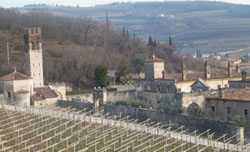 The DOCG area today incorporates some 4,900 hectares of steep hillside vineyards, where almost all vineyard maintenance needs to be fulfilled manually, involving hours of careful labour tended to by about 166 sparkling producers. The DOCG area today incorporates some 4,900 hectares of steep hillside vineyards, where almost all vineyard maintenance needs to be fulfilled manually, involving hours of careful labour tended to by about 166 sparkling producers.
Prosecco DOCG production is still on the rise, from 40m bottles produced in 2003 to 69m in 2011, and possibly just over 70m predicted for 2012.The DOC zone has roughly double the vineyard area of the DOCG, but makes more than four times the amount of wine, predicted to soar to 280m bottles a year by 2012.
According to the Consorzio it is a difficult task to explain to export markets that the cru areas relating to Prosecco DOCG’s premium production areas – known as Rive – are on steep gradients which cannot be mechanized, hence their higher quality but also their higher cost of production.
Sicily
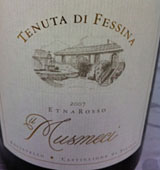 The quality of production in Sicily has improved tremendously compared to some thirty years ago. Until the early 80’s Sicily was primarily producing vast quantities of bulk wine used for blending wines of the north and often shipped as far as France. The quality of production in Sicily has improved tremendously compared to some thirty years ago. Until the early 80’s Sicily was primarily producing vast quantities of bulk wine used for blending wines of the north and often shipped as far as France.
The most significant changes in Sicily’s production took place in the mid-eighties thanks to a number of family estates including Planeta, Donnafugata and Tasca d’Almerita among the benchmark of Sicilian wines placing Sicily on the global map in terms of international acclaim and reliable quality production.
Over the past 20 years IRVOS-Istituto Regionale Vini e Olii Sicilia - Sicily’s Regional Institute for Viticulture and Olive Oil, has contributed enormously to establishing vineyard management, research, and clonal selection of its main indigenous varietals such as, Nero d’Avola, Carricante, NerelloMascalese, Cataratto and Inzolia, which today constitute the new image of Sicilian winesproduced by a number of emerging quality wineries beginning to play a growing role in the international arena.
Sicily has 23 DOC areas (appellations) of production and one DOCG- Cerasuolo di Vittoria. It boasts a total of 119.893 hectares, of which 76.906 (64,1%) hectares are planted to white varietals and 42.839 hectares (35,7%)are planted to red varietals. The emblem of Sicilian wine by far and large in terms of plantings and popularity is still the red varietal Nero d’Avola, and the white indigenous variety Catarratto.
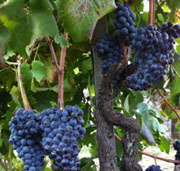 Nero d’Avola does well in most of Sicily’s appellation areas, because it is a terroir wine, changing its character, depending on where it is planted. If you are looking to produce a modern style of wine, characterized by a rounded, fruity appeal and easy drinking, then Menfi and Sambuca in western Sicily are the best areas to plant Nero d’Avola, whereas if you are looking for a more complex Cru showing elegance, aromas and acidity with good ageing potential, then the area of Noto, Vittoria and Ragusa in the southeast are excellent areas. Conte di Sclafani in the centre of Sicily is another area with excellent potential, yielding age-worthy structured wines with bold fruit. Nero d’Avola does well in most of Sicily’s appellation areas, because it is a terroir wine, changing its character, depending on where it is planted. If you are looking to produce a modern style of wine, characterized by a rounded, fruity appeal and easy drinking, then Menfi and Sambuca in western Sicily are the best areas to plant Nero d’Avola, whereas if you are looking for a more complex Cru showing elegance, aromas and acidity with good ageing potential, then the area of Noto, Vittoria and Ragusa in the southeast are excellent areas. Conte di Sclafani in the centre of Sicily is another area with excellent potential, yielding age-worthy structured wines with bold fruit.
The most recent trend-setter in Sicily can be found on theunique volcanic slopes of Etna. Its terraced vineyards of ancient bush-trained vines produce wines of depth and finesse characterized by minerality and elegance, similar to Burgundy wines. Top bottlings of Etna Rosso DOC are made from Nerello Mascalese and Nerello Cappuccio while Etna Bianco DOC is made predominantly with Carricante grapes. These wines have gained a lot of attention on account of their uniquequality and subtle aromatic profile.
Michèle Shah
 Michèle Shah is a marketing consultant, and a wine critic based in Italy for over 30 years, specialized in promoting Italian wines to export markets.She organizes tasting events and workshops at Italian trade events likeVinitaly and on behalf of Italy’s regional Consorzios for various programmes for international press and international wine buyers.She writes for several magazines and is Italy correspondent for several international magazines. She was adjudged the Best Foreign Wine journalist by the Grandi Cru d’Italia in 2009-editor Michèle Shah is a marketing consultant, and a wine critic based in Italy for over 30 years, specialized in promoting Italian wines to export markets.She organizes tasting events and workshops at Italian trade events likeVinitaly and on behalf of Italy’s regional Consorzios for various programmes for international press and international wine buyers.She writes for several magazines and is Italy correspondent for several international magazines. She was adjudged the Best Foreign Wine journalist by the Grandi Cru d’Italia in 2009-editor
|